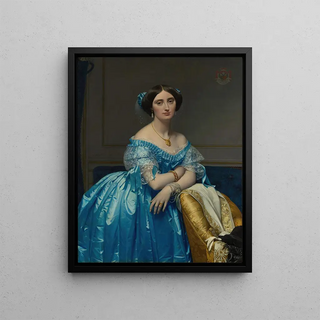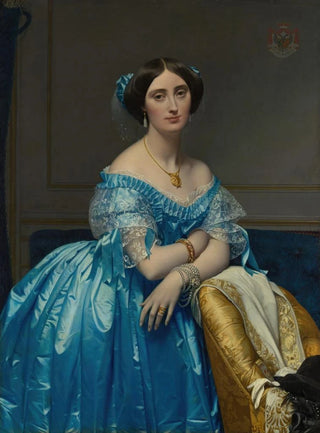Art print | Joséphine-Éléonore-Marie-Pauline de Galard de Brassac de Béarn Princess de Broglie - Jean-Auguste-Dominique Ingres


View from behind

Frame (optional)
In the fascinating world of art, some works transcend time and eras, captivating the eye and the mind. The art print of Joséphine-Éléonore-Marie-Pauline de Galard de Brassac de Béarn Princess of Broglie by Jean Auguste Dominique Ingres is a perfect example. This portrait, created in 1853, embodies the elegance and refinement of the 19th century, while revealing the complex personality of its model. Joséphine, a woman of letters and muse, is depicted here with unmatched grace, evoking both beauty and intelligence. The piece, both intimate and majestic, invites the viewer to immerse themselves in a world where nobility blends with art, creating an atmosphere filled with mystery and seduction.
Style and uniqueness of the work
Ingres's style is distinguished by its precision and attention to detail, characteristics that are evident in this iconic portrait. The chiaroscuro technique, used masterfully, emphasizes the delicate features of Joséphine, while creating a striking depth. The drapery of her dress, carefully rendered, seems almost tangible, while the dark background highlights the luminosity of her face. Ingres excels in depicting textures, and every element of the composition, from jewelry to hair, demonstrates his incredible skill. But beyond technique, it is the psychology of the character that emerges powerfully. Joséphine's eyes, sparkling with intelligence, seem to tell a story—of a woman who is both strong and vulnerable, rooted in her time yet aspiring to emancipation.
The artist and his influence
Jean Auguste Dominique Ingres, an emblematic figure of Neoclassicism, left a lasting mark on art history with his unique approach to portraiture. Trained at the Academy of Painting, he skillfully combined the legacy of old masters with a personal vision, creating an unmistakable style. His influence extends far beyond his era, inspiring many

Matte finish

View from behind

Frame (optional)
In the fascinating world of art, some works transcend time and eras, captivating the eye and the mind. The art print of Joséphine-Éléonore-Marie-Pauline de Galard de Brassac de Béarn Princess of Broglie by Jean Auguste Dominique Ingres is a perfect example. This portrait, created in 1853, embodies the elegance and refinement of the 19th century, while revealing the complex personality of its model. Joséphine, a woman of letters and muse, is depicted here with unmatched grace, evoking both beauty and intelligence. The piece, both intimate and majestic, invites the viewer to immerse themselves in a world where nobility blends with art, creating an atmosphere filled with mystery and seduction.
Style and uniqueness of the work
Ingres's style is distinguished by its precision and attention to detail, characteristics that are evident in this iconic portrait. The chiaroscuro technique, used masterfully, emphasizes the delicate features of Joséphine, while creating a striking depth. The drapery of her dress, carefully rendered, seems almost tangible, while the dark background highlights the luminosity of her face. Ingres excels in depicting textures, and every element of the composition, from jewelry to hair, demonstrates his incredible skill. But beyond technique, it is the psychology of the character that emerges powerfully. Joséphine's eyes, sparkling with intelligence, seem to tell a story—of a woman who is both strong and vulnerable, rooted in her time yet aspiring to emancipation.
The artist and his influence
Jean Auguste Dominique Ingres, an emblematic figure of Neoclassicism, left a lasting mark on art history with his unique approach to portraiture. Trained at the Academy of Painting, he skillfully combined the legacy of old masters with a personal vision, creating an unmistakable style. His influence extends far beyond his era, inspiring many






